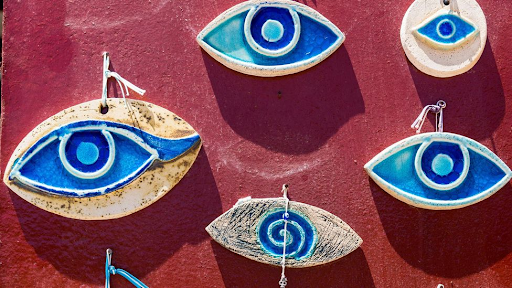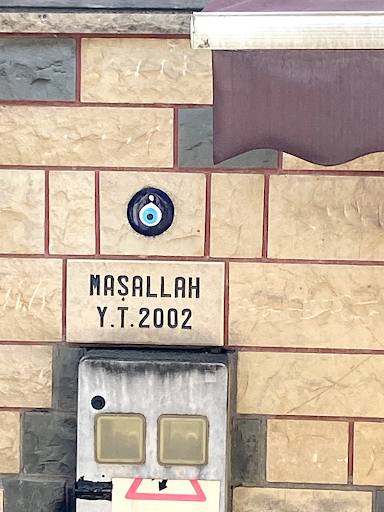Culture Spotlight: The Evil Eye: Learn to Protect Yourself
By Rana Ansari
Take a moment and think back to your senior year, when you were applying to colleges. Waiting back to hear the decisions was always the hardest part. Every vibration on your phone made you think of that one school, that dream school. Every unopened email could have the best or the worst news. Every day was a day closer to hearing your fate for the next four years. Then, the day comes, you receive THE email. You start to shake as you navigate to your email, and hold your breath as you click on ‘view decision’.
“Congratulations….” You let out a sigh of relief and a cry of joy. What’s next? Do I call my mom, dad, sister, and friends? Do I post about it on social media?
You fear that the evils of Hassad (الحســـد), the Arabic word for envy, will be inflicted upon you!
At least that’s what some of us would do.
The concept of the evil eye is deeply rooted in many cultures throughout East Asia, the Middle East, Central America, and many more. Generally, it is believed that envy, or the evil eye, can inflict harm on someone. This could be rooted in evil intentions, or there could be none at all. To combat this, the evil eye amulet was, and still is, used as a form of protection from this harm.

The evil eye first appeared in ancient Mesopotamia, or modern-day Iraq and Syria. Clay statues were incised with eyes, those that represent the evil eye. These idols were retained throughout the time of the Assyrians and Phoenicians and even made their way to Greece and Rome, where in the sixth century BC, the evil eye design was drawn on drinking vessels and other pottery. There is evidence of Plato describing the evil eye as “a curse given to someone when they were unaware.”
Throughout the history of civilization, the evil eye has spread to several many different cultures, religions, and societies. As a result, many people place the evil eye in high regard in their traditions and customs. Many languages have even adopted words and phrases to refer to the evil eye. In the romantic languages, like French and Spanish, respectively, the evil eye is called Mauvais Oeil and Mal de ojo. In other languages, a whole word was created to refer to the evil eye, like in Swedish where the word Ondaögat is used, and Hungarian has Szemmelverés. In Farsi, there’s cheshm khordan, which translates literally to being struck in the eye. The more universal term, nazar, is used in several different languages and countries such as Turkey and India.
Over time, the design of the evil eye retained its main design, the classic blue, black, and white layered ovals and circles. However, as it spread to other cultures and groups, the variations of the design appeared, but the concept stayed the same, regardless of where in the world you are.
A freshman student in the honors college, Nial Dayalsingh, views the evil eye as something similar “to a curse where someone is so jealous of you that they have ill will or want harm to come your way, sometimes this is an active intention (where someone will literally spit over your back or towards you or pray for your downfall) or inactive where their jealousy alone harms you. The evil eye brings bad luck and worry.” Having roots from Guyana and actively practicing a Christian faith, Nial acknowledges that while the term “evil eye” is not used directly, there are still the same beliefs found in traces in ancestral religious customs and traditions.
Sometimes, the evil eye may be portrayed in the form of a hand. For Arabs, this is called the khamsa, the Arabic word for five, referring to the five fingers. Similarly, Hebrew has the word “Hamsa” to describe the same symbol. Since the Phoenicians, the hand was the symbol of a feminine entity serving as a form of protection. Throughout history, religions and cultures have adopted it and have become just as common as the evil eye. When the evil eye started making its way into religions, the Khamsa started to become a symbol for the protection of God against the harm of the evil eye.
As seen with the Khamsa, the evil eye has made its way into several religions, the main ones being Islam, Judaism, Christianity, Buddhism, and Hinduism. In Islam, while the ‘eye’ itself is not what is believed to provide direct protection, there are religious protections against what is known as Al-Ayn (العين) or Hassad (الحســـد). Mentioned 5 times in the Quran, the evil eye is a large part of cultures that predominantly practice Islam.
Shaheer Alam, a freshman in the Honors College, recognizes the evil eye as something that his parents would always bring up in his Muslim, Pakastani-Indian household. “They were telling me to constantly say ‘MashAllah’ (What God has willed) even though I didn’t fully understand it. I was told that it [the evil eye] was the result of someone being jealous of you. If someone had something successful happen to them and someone else felt jealous of that, the successful person might have misfortune happen to them. I didn’t understand why jealousy in general was so destructive until now. Besides the bad luck associated with receiving jealous looks, jealousy itself can destroy long-lasting friendships.”
Overall, though, this part of his culture and religion mostly serves as an important reminder. “To me, the evil eye serves as a reminder to stay humble and wish the best for everybody.”
Walking through the streets of almost any foreign country, it is almost inevitable that one would run into decorations with the evil eye. In Turkey, almost everything is adorned with the characteristic drawing of the evil eye. Cars, trucks, entryways in buildings, mosques, and even street signs are protected from any evil that could be inflicted. 
In the home, evil eye amulets are traditionally hung up. Keychains and charms are given as a gift to newborns, as a housewarming gift, to newlyweds, and for several other occasions. Another commonality that I have experienced in my Iraqi household is the burning of Rue seeds. A strong scent is released throughout the home, and it is thought that it is strong enough to scare away the evils of the evil eye. Whenever I have a big test coming up, or there’s a special event like a wedding, the seeds are kept out for several days. It is also very common in the Persian culture to burn the seeds, or in Farsi, Espand.
Today, many use the evil eye as fashion statements on jewelry and interior decoration in personal spaces. Celebrities like Kim Kardashian and Miley Cyrus have shown off their evil eye amulet jewelry on social media, prompting major jewelry companies such as Swarovski and Pandora to create an “evil eye” collection. These can even be found in major stores like Bloomingdales, Macy’s, and Neiman Marcus. As the symbol becomes increasingly popular, it is important to remember where the symbol comes from and the meaning that it carries. While there are some people (mostly only me) that take the evil eye almost too seriously, it’s important to remember its place in history, as it has existed since the dawn of civilization.
As someone who loves to express this part of my Iraqi-American identity, walking around the Honors college to see my peers wearing their evil eye jewelry or hanging up on their dorm doors brings me so much joy. The Honors college is full of diversity and different stories, and the evil eye is one of those many examples to show how connected we all are, especially among diversity.